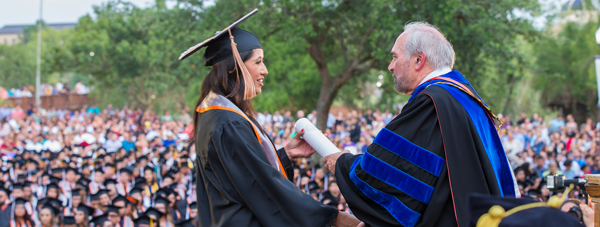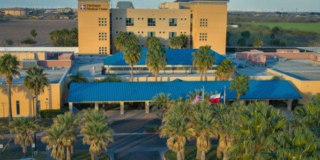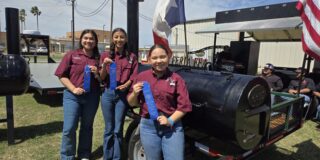- La Feria Native Soon To Retire From The Military This Summer
- Senior Eneece Avila Takes Pride in her State Title
- Dr. Noemi Infante, Harlingen Medical Center Open New Women’s Clinic
- Santa Rosa Cameron County Park Partially Reopens
- Santa Rosa Takes to Regionals Meet in Kingsville, Tx
- Long-Standing Nexstar Tower in La Feria Decommissioned
- Lionettes Powerlifting Meet
- Local Business Holds Event to Benefit RGV Shriners Club
- Knights of Columbus Holds it’s 30th Annual Golf Tournament
- KGBT Tower Dismantled
UTRGV’s Legacy Institution UTPA Ranked High in Stanford Study of ‘Mobility Rates’
- Updated: July 28, 2017
by Cheryl Taylor
RIO GRANDE VALLEY, TEXAS – An online magazine that ranks colleges in a variety of categories has recognized The University of Texas Rio Grande Valle
y for its ability to enroll a large number of students from low-income backgrounds and graduate them into promising careers that help them climb the income scale.
The recognition is one of several accolades for the two-year-old university. In January, UTRGV was named a Social Mobility Innovator by CollegeNET Inc., and in February it was recognized in a Vox.com article titled “These colleges are better than Harvard at making poor kids rich.”
University leaders say that for current and future UTRGV students, rankings like the ones mentioned mean that the education and training being offered by UTRGV can truly be life-changing.
“Isn’t that what higher education is all about,” UTRGV President Guy Bailey said. “We tell students all the time that investing in higher education can lead to a better life for them and their families, and it’s so satisfying to see that we’re fulfilling that hope.”
The study – conducted by the Equality of Opportunity Project, a research group based out of Stanford University – looked at graduates of UTRGV legacy institution The University of Texas Pan American who attended between the years 2000 and 2011. UTPA ranked number five.
“This ranking confirms the significant impact of higher education on the quality of life of our students and their families. Obtaining a degree from UTRGV or our legacy institutions has had and will continue to have a big impact on our students and their families,” said Dr. Kristin Croyle, vice president for Student Success at UTRGV.
A number of factors contributed to this outcome, she said, including determined students, outstanding faculty, excellent educational programs, generous financial aid programs, and family support.
“This report validates the positive educational impact UTRGV has on our students,” Croyle said. “Our goal, and our responsibility, is to provide the very best educational opportunities for our students. They deserve no less.”
EOP’S RANKING METHODOLOGY
A college’s mobility rate, as defined by EOP, is the product of access, meaning the fraction of students who come from families in the bottom fifth income bracket, and its success rate, meaning the fraction of such students who reach the top fifth.
The EOP research, entitled “Mobility Report Cards: The Role of Colleges in Intergenerational Mobility,” attempts to answer these two questions:
- Which colleges in America contribute the most to helping children climb the income ladder?
- How can we increase access to such colleges for children from low income families?
The principal investigators on the EOP are economists Raj Chetty of Stanford University, John Friedman of Brown University, and Nathaniel Hendren of Harvard University. The three principal investigators worked with Nicholas Turner, a financial economist in the Office of Tax Analysis, U.S. Department of the Treasury, to track about 30 million students born between 1980 and 1991.
The researchers linked tax returns to attendance records from nearly every college in the country, covering all students from 1999 to 2013.
“We used data on 30 million college students to construct mobility report cards – publicly available statistics on students’ earnings and their parents’ income – for each college in America,” the EOP report says. “Our analysis sheds light on how colleges shape children’s prospects of upward mobility and how we can help more children climb the income ladder through higher education.”
‘MID-TIER’
Researchers determined the colleges that have the highest upward-mobility rates typically are mid-tier public schools that have both large numbers of low-income students and very good outcomes.
The term mid-tier refers to a definition based on a cross-tabulation of a set of variables, as determined by a selectivity index created by Barron’sweekly newspaper and published by Dow Jones & Company.
UTPA falls into this mid-tier category, a non-selective public/private not-for-profit university.
In the Vox.com article cited above, “These colleges are better than Harvard at making poor kids rich,” writer Dylan Matthews says:
“… The true heroes that come out of the research are not Ivies (Ivy League schools), but less selective schools that accept a large number of students from low-income backgrounds and help them climb the income scale. They include schools like the City College of New York, or Cal State Los Angeles, or University of Texas Pan American (which has since become UT Rio Grande Valley). All three of those schools took more than a fifth of their students from the bottom fifth of the income scale, and all three are in the top 10 schools ranked by the share of students who move up two or more income quintiles.”
The mission of the Equality of Opportunity Project, as stated on its website, is “to develop scalable policy solutions that will empower families to rise out of poverty and achieve better life outcomes. We aim to achieve this mission by harnessing the power of big data to learn from areas where the American Dream is still thriving.”
ADDITIONAL MATERIAL AND ARTICLES
- Watch a TEDxStanford Talk with Raj Chetty: Reviving the American Dream: Lessons from Big Data: https://www.youtube.com/watch?v=u2U9-Wq2ub0
- A January 18, 2017, New York Times story on the EOP research, “Some Colleges Have More Students from the Top 1 Percent than the Bottom 60. Find Yours,” includes an interactive component – https://www.nytimes.com/interactive/2017/01/18/upshot/some-colleges-have-more-students-from-the-top-1-percent-than-the-bottom-60.html?smid=fb-nytimes&smtyp=cur – in which you can add virtually any college in the United States to the list, to see where it stands within several criteria.
- National Public Radio reporter Sophia Alvarez Boyd conducted a Q&A with Professor Chetty regarding the EOP research. “Which Colleges Might Give You The Best Bang For Your Buck” is dated February 26, 2017.








